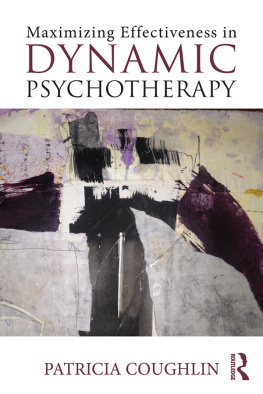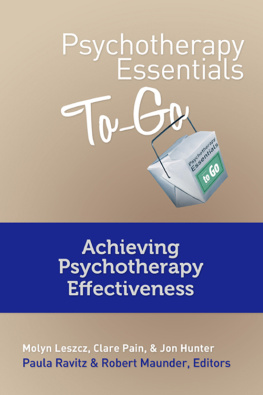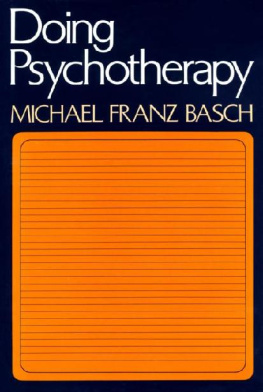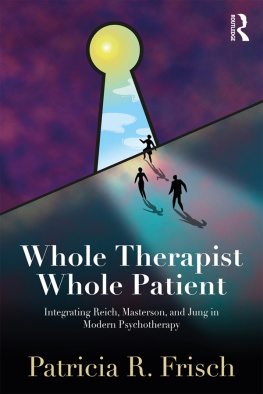Maximizing Effectiveness in Dynamic Psychotherapy
The best therapists embody the changes they attempt to facilitate in their patients. In other words, they practice what they preach and are an authentic and engaged, as well as highly skilled, presence. Maximizing Effectiveness in Dynamic Psychotherapy demonstrates how and why therapists can and must develop the specific skills and personal qualities required to produce consistently effective results. The six factors now associated with brain change and positive outcome in psychotherapy are front and center in this volume. Each factor is elucidated and illustrated with detailed, verbatim case transcripts. In addition, intensive short-term dynamic psychotherapy, a method of treatment that incorporates all these key factors, is introduced to the reader.
Therapists of every stripe will learn to develop and integrate the clinical skills presented in this book to improve their interventions, enhance effectiveness and, ultimately, help more patients in a deeper and more lasting fashion.
Patricia Coughlin (Della Selva), PhD, is a clinical psychologist with more than thirty years of experience as a psychodynamic therapist, international teacher/trainer, and author. She has been a clinical professor of psychiatry at Northwestern University School of Medicine, Albany Medical College, and Jefferson Medical College. Currently, she conducts a private psychotherapy practice in Albany, New York, and she is a visiting scholar at the University of New Mexico School of Medicine. Her book Intensive Short-Term Dynamic Psychotherapy is considered a classic in the field.
First published 2017
by Routledge
711 Third Avenue, New York, NY 10017
and by Routledge
2 Park Square, Milton Park, Abingdon, Oxon, OX14 4RN
Routledge is an imprint of the Taylor & Francis Group, an informa business
2017 Patricia Coughlin
The right of Patricia Coughlin to be identified as author of this work has been asserted by her in accordance with sections 77 and 78 of the Copyright, Designs and Patents Act 1988.
All rights reserved. No part of this book may be reprinted or reproduced or utilised in any form or by any electronic, mechanical, or other means, now known or hereafter invented, including photocopying and recording, or in any information storage or retrieval system, without permission in writing from the publishers.
Trademark notice: Product or corporate names may be trademarks or registered trademarks, and are used only for identification and explanation without intent to infringe.
Library of Congress Cataloging-in-Publication Data
Names: Della Selva, Patricia Coughlin, 1954 author.
Title: Maximizing effectiveness in dynamic psychotherapy / Patricia
Coughlin.
Description: New York, NY : Routledge, 2016. | Includes bibliographical
references and index.
Identifiers: LCCN 2015050555 | ISBN 9781138824966 (hardback :
alk. paper) | ISBN 9781138824973 (pbk. : alk. paper) |
ISBN 9781315740249 (ebook)
Subjects: LCSH: Psychodynamic psychotherapy.
Classification: LCC RC489.P72 D45 2016 | DDC 616.89/14dc23
LC record available at http://lccn.loc.gov/2015050555
ISBN: 978-1-138-82496-6 (hbk)
ISBN: 978-1-138-82497-3 (pbk)
ISBN: 978-1-315-74024-9 (ebk)
Typeset in Minion
by Apex CoVantage, LLC
To my patients and trainees, who have contributed more to my life than theyll ever know.
Contents
It is a genuine privilege to be a partner in the transformation of patients lives, from suffering and constriction, to aliveness and authenticity. The remarkable courage and generosity of those who have allowed their treatments to be videotaped, shared, and studied in an effort to help others is both touching and inspiring. I am a far better person and therapist for having known you all.
I am profoundly grateful to Drs. Habib Davanloo and David Malan for their courageous and steadfast determination to discover new and effective means for reaching ambitious therapeutic results in a rapid and consistent fashion. Their contributions to the field have been immense. It is my hope that this book will aid in the dissemination of this vital information to a broad audience of therapists who are eager to learn more productive and efficient ways to help their patients.
My trainees have taught me much, and I learn from each and every one of them. Special thanks to Torben Palmer Hansen and Mark Vail, who spent countless hours editing and subtitling my videotapes for training purposes, and to Angela Cooper for reading several of these chapters along the way, and Lucas Jones, who edited the volume with great care. To Tor Wennerberg, enormous thanks for the countless invigorating and illuminating discussions about every aspect of theory and techniquenot to mention life itself!
My colleagues have been remarkable resources and, in many cases, have become valued friends. My work and my life have been deeply affected by you all. In particular, Allan Abbass, Bjorn Elwin, Jon Frederickson, Diana Fosha, Allen Kalpin, Jeff Katzman, Laura Mott, Kristin Osborn, and David Wolff have been models of compassion, devotion, and dedication to excellence in our field. Their inspiration and support have been invaluable.
To all my dear friends and comrades in arms, especially Elaine Appellof, Diane Byster, Susan Fisher, Karen Hastings, Bonnie Miller, Sandy Rainbow, Diana Shulman, Lise Suino, Andrew Ursino, Kathy Thiel, and Jody Whitehouse. I cant imagine my life without you.
Finally, I owe an enormous debt of gratitude to Bruce Ecker, who introduced me to Anna Moore at Routledge. And, last but not least, to Zoey Peresman, for her kind, constructive, and incisive feedback on this manuscript. The book is far better for her contribution to it.
Chapter One
Maximizing Effectiveness in Dynamic Psychotherapy
Introduction
| Therapist: | Why dont you start by telling me what brings you and what kind of help you are looking for? |
| Patient: | I dont know. I think I have to decide. This is the problemand I do have a close friend I talk to about this. I may beuhI have satuhall my life and because of anxietyshe feelsand I asked her because she knows me since graduate schoola lack of self-esteem, anxiety, inability to make a decision. I just sit and I really havent gotten any I think its too late to get where I want to get at 69, so I go through a little anger about this nastiness about being an old maid. |
This 69-year-old woman had seen countless therapists over many decades without receiving any benefits. Her opening statement was both incoherent and dismissive in tone, suggesting a highly disorganized attachment style; while her nonverbal communication consisted of rather bizarre and distorted facial expressions. She was apparently driving her primary care physician to distraction with repeated calls for appointments to address vague and varied physical complaints. Overall, she personifies the kind of complex and difficult patient therapists often see, but too rarely help.
How can we refine our skills and develop our full capacity as healers, so that we can have a better chance of helping such patients? This book will attempt to answer this question. I will introduce the reader to six factors associated with brain change in adults, along with the specific techniques of demonstrated efficacy associated with these factors: (1) focus and repetition, (2) creating and maintaining a collaborative alliance, (3) inducing moderate levels of anxiety, (4) facilitating multiple levels of emotional activation, (5) creating profound moments of meeting, and (6) developing a coherent life narrative. In order to accomplish these goals, specific skills designed to help patients relinquish the defenses that interfere with optimal emotional activation and active collaboration with the therapist are required. No matter how effective our methods and techniques, they will be rendered useless if patients remain uninvolved in the process.








